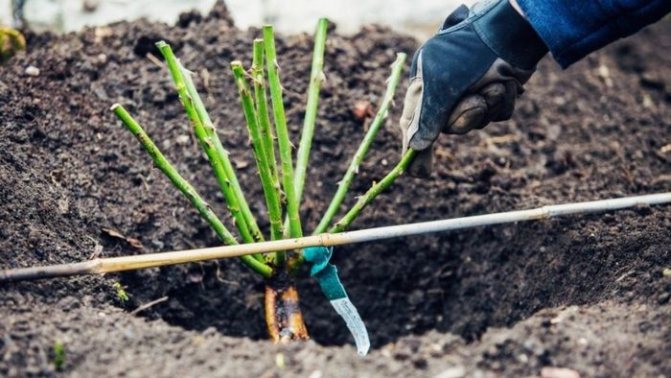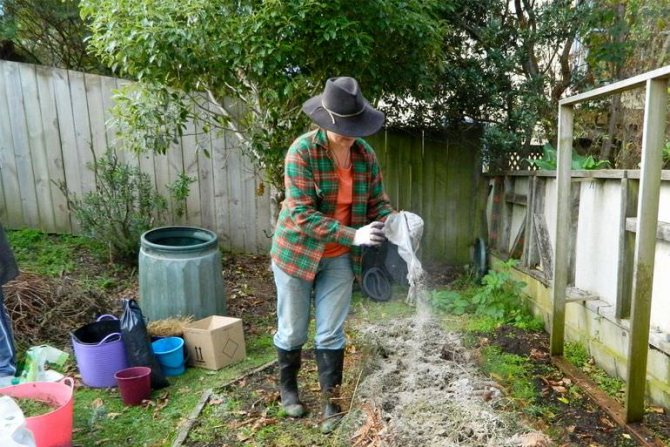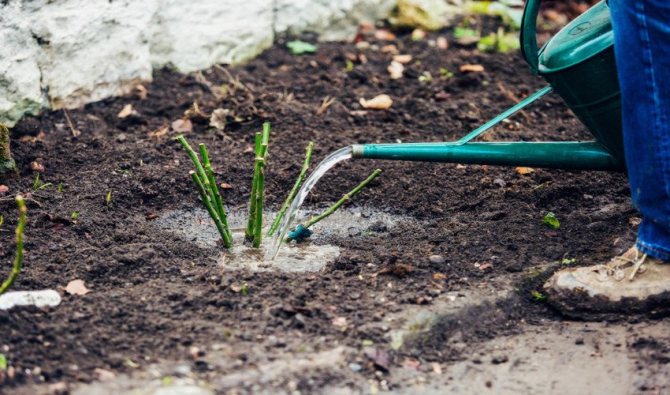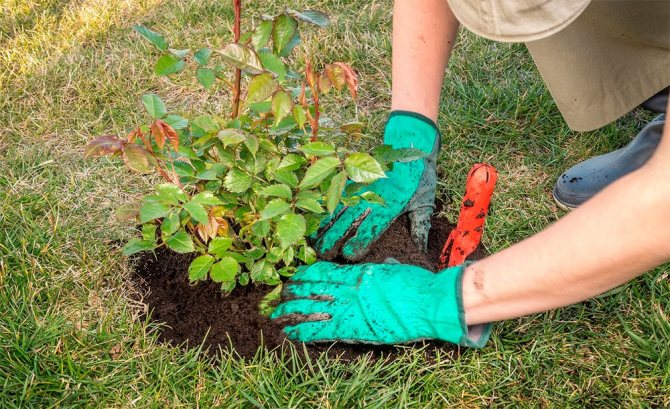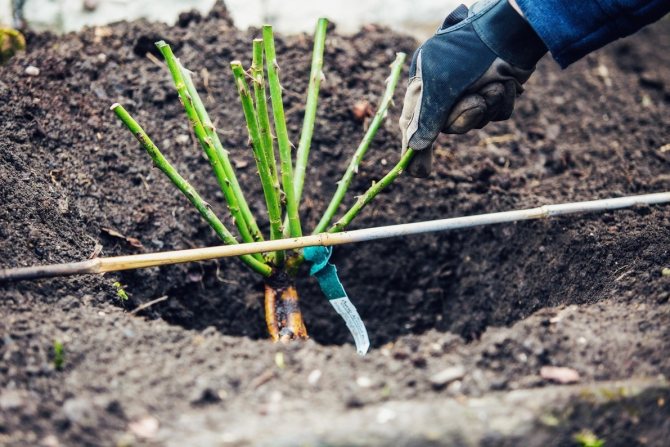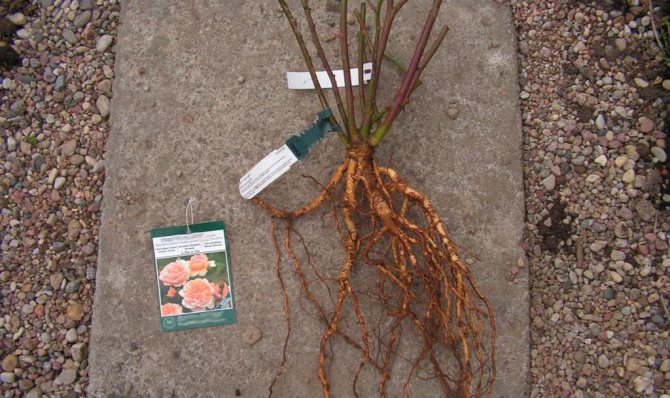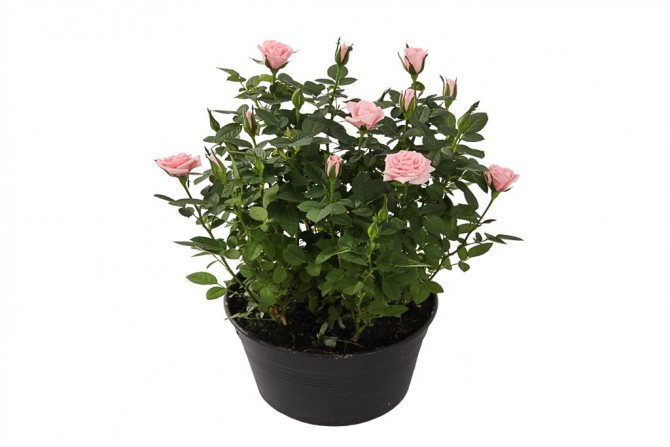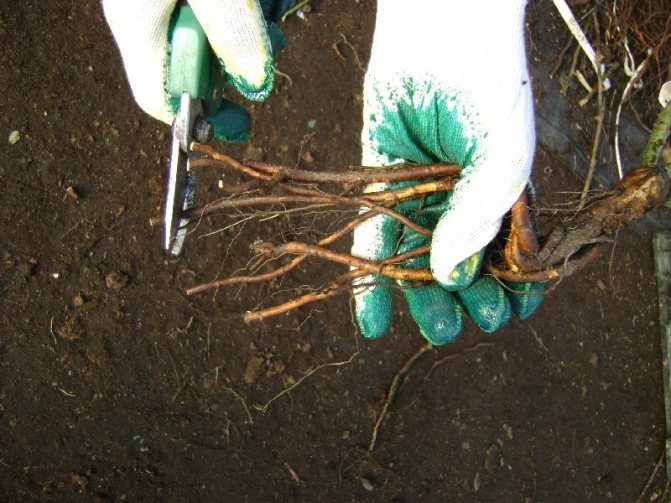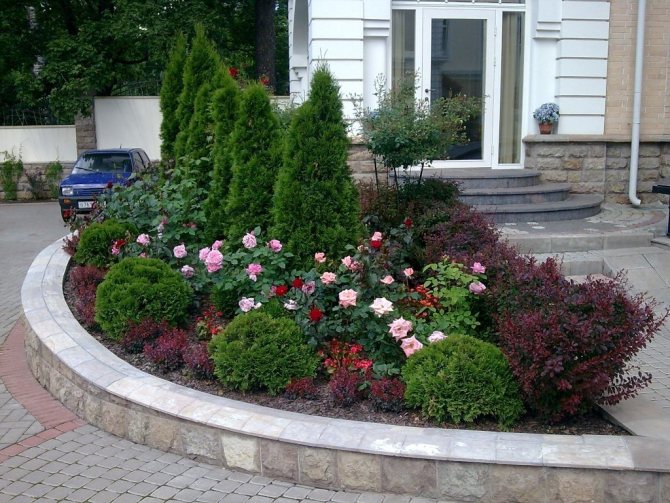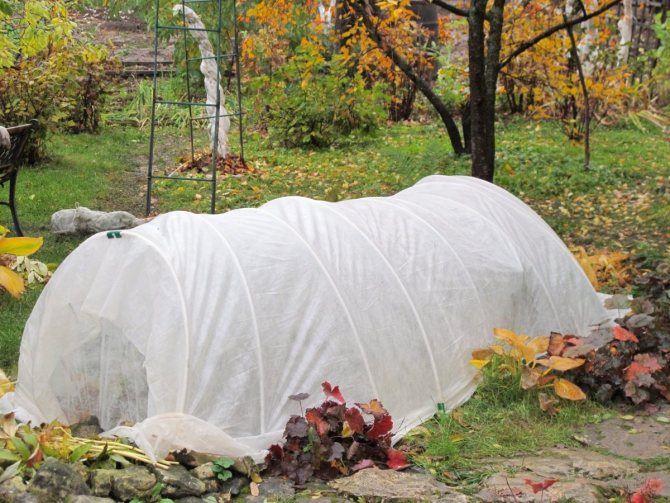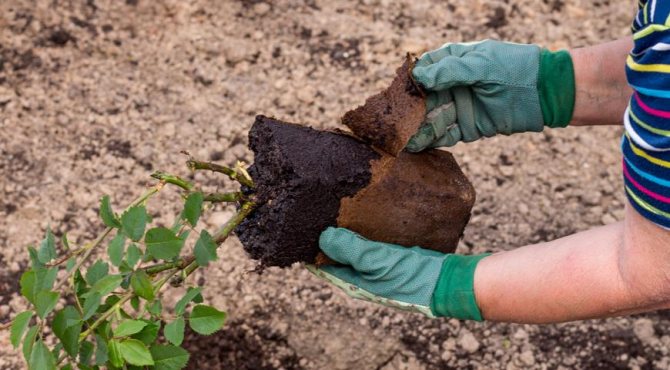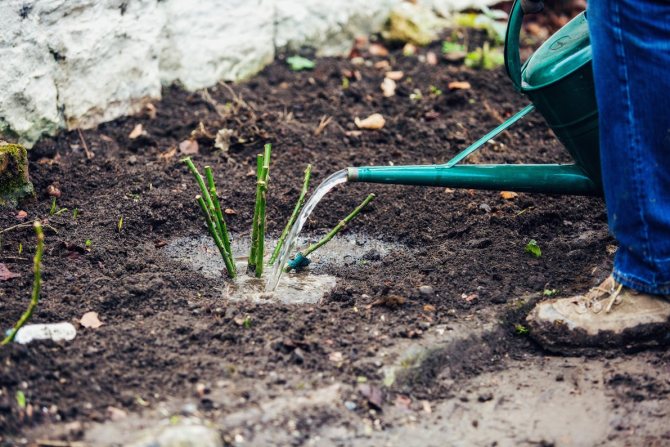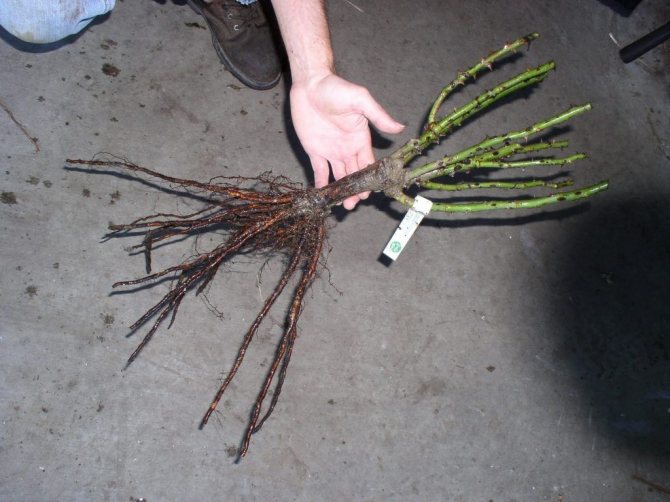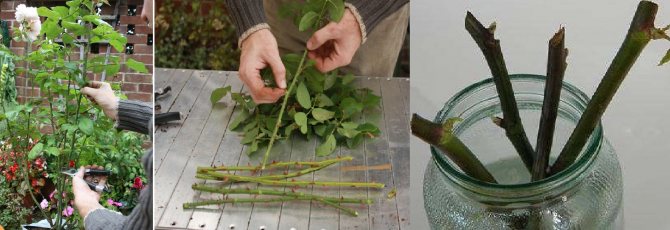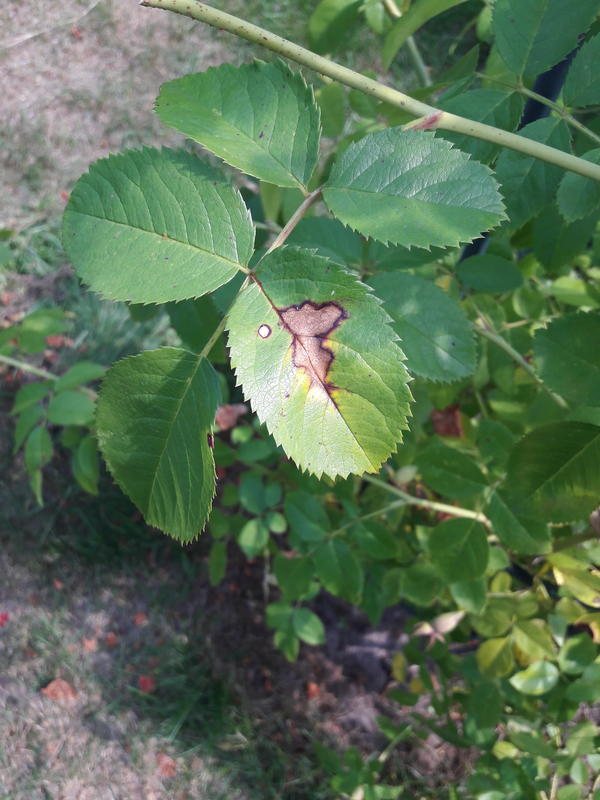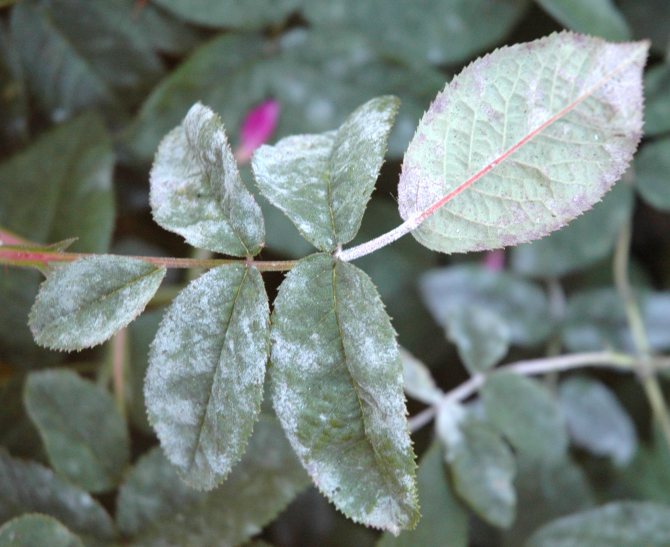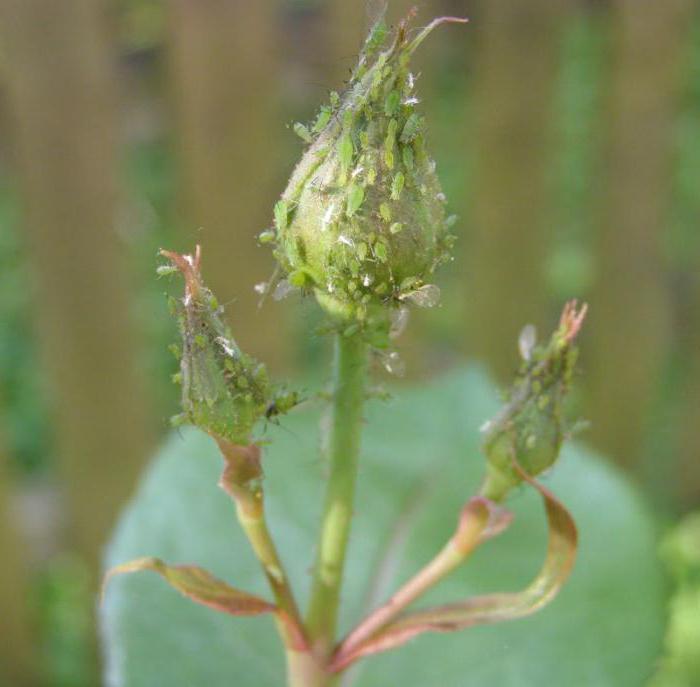The rose is the most beautiful creation of all flowers. It is not in vain that she is called the queen of the garden, because she is endowed with a bright and catchy beauty that leaves an indelible mark on the soul. But before starting it in their garden, gardeners are wondering whether it is possible to plant roses in the country in the fall, how to carry out the procedure correctly, what are the features and rules for autumn planting. All the answers to these questions are below!
Planting roses in autumn
All seasoned gardeners believe that planting roses in the fall is the most suitable option for the best rooting of these luxurious flowers and creating favorable conditions for growth. In autumn, there are no temperature drops, humidity stabilizes, there is no need to provide plants with constant watering. Another significant advantage of autumn planting is the ability to acquire healthy seedlings, and not specimens that are weakened and depleted after winter. To grow the "queen of flowers", you need to determine the optimal timing for planting, choose seedlings that can adapt to any weather, follow simple rules for caring for a rose.
How to root different types of roses in autumn
Planting various types of roses has its own nuances - it is these subtle points that we will consider further.
Park roses
These plants are distinguished by their unpretentious nature, they are able to grow in almost any soil, they are resistant to both heat and cold. They are planted according to the standard above scheme.
Climbing
This category includes curly, liana-like varieties of roses that can twine around a support. Before planting these plants, it is recommended to shorten their roots to 35 cm, the lashes are usually not touched. It is imperative to provide a support next to the rooting site: an arch, a pillar, a trellis, a frame.
If the rose is climbing, its root collar deepens when planting by 5 cm, if the standard rose - by 10 cm.
Groundcover
It is recommended to plant these roses on a small elevation with a slope: ground cover roses are extremely negative about an excess of moisture in the soil.
Floribunda and teahouses
Autumn planting for these varieties is not very recommended: it is better to plant them in the spring. The holes are dug out with the parameters of half a meter by half a meter, the same distance is left between them when planting several bushes.
Features of planting seedlings in the autumn

Simple rules for planting roses will help even inexperienced gardeners grow beautiful flowers:
- The most important thing when planting roses is to provide an acceptable distance for the development of flowers.
- Choose an illuminated place, but closed from the scorching rays of the sun at noon. If planted in shaded areas of the garden, the rose may die, and direct midday sunlight will burn the leaves. It is recommended to root the seedlings in the southeastern or western side of the garden, so that at noon the shadow covers the roses, and in the morning the sun caresses the flowers with its warm rays.
- It should be planted at a slope of 30 - 40 cm. In this case, the plant will overwinter even in severe winter frosts, and in spring melt water will bypass these beautiful flowers.
- When planting, take into account the moisture, acidity of the soil. Excessive moisture levels will negatively affect roses. The most optimal soil acidity is 6.0 - 6.5 pH.
- It is not recommended to select for planting land on which cherries, hawthorns, apricots and other rosaceous plants grew.
- Roses are planted in the ground in autumn in warm, calm weather.
- Seedlings should be selected with a developed root system, the number of shoots is at least 3 pieces and the diameter of the upper root is 8 - 10 cm. Gently scratch the root with your fingernail - it should have an elastic structure, white shade.
Features of planting different types of roses
Almost all varieties of roses are planted in the autumn according to the above scheme. But there are exceptions:
- Stamp roses with open roots are planted at an inclination of 45 °. This will prevent damage to the stem in the process of bending it down for shelter for the winter. Moreover, the bush should be tilted to the same side into which the stem will be bent. The main thing is that the slope is not directed towards paths, curbs and other hard surfaces.
- Climbing roses are buried so that the root collar is 8-10 cm below the soil surface. Bushes are planted near the support. Moreover, the distance from the plant to the support should be about 30 cm.
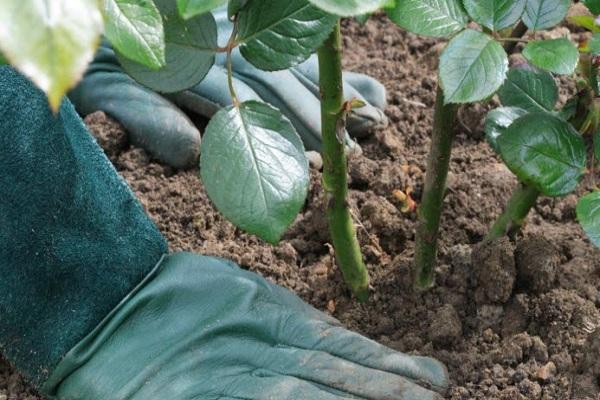

Planting process
If you follow a simple algorithm of actions when planting roses in the fall, even the most fastidious specimens will delight in the spring with blossoming buds:
- Clear the area of weeds.
- Dig up the soil half a meter, with fertilization (1.5 kg of rotted manure or compost for each seedling). Apply ash and mineral fertilizers.
- The planting hole should be wide and deep - 60 by 50 cm. It is recommended to prepare it in the spring, or at least 2 to 3 weeks in advance. 10 days before planting, the holes are filled with water, humus is added.
- Place the seedling so that the thickening between the rhizome and the branches is 2 to 3 cm below ground level. Tamp the soil, the roots should be firmly attached to the ground.
- Water the rose liberally. If the soil has settled after absorbing water, add the potting mix on top.
- Do not plant flowers too densely - this can provoke diseases in plants, they will not pick up color well. Too rarely, it is also not recommended to form - the earth around the bushes will dry out.
Preparing a planting hole for a rose bush
Planting rose seedlings step by step:
- Dig a hole 40 cm in diameter and 50-70 in depth.
- Arrange a drain at the bottom of the pit. Drainage can be broken brick, pebbles, expanded clay.
- Pour a pile of fertile soil at the bottom of the hole. For filling the holes, the topsoil is used. They add to it: organic matter (better than rotted cow dung) 8 kg per planting pit, superphosphate - 25 g each, potash fertilizers - 10 g each. All soil is mixed well.
- Prepare rose seedlings and process if required before planting
How to care for a rose after planting?
After the onset of the first night frosts, it is worth taking care of the covering material so that the planted rose is more comfortable to survive the long winter. Below are recommendations on how to cover plants for the winter:
- Cover the soil with fir twigs.
- Pour dry leaves, shavings, sawdust on top with a layer of 15 - 20 cm.
- Press down the insulation layer with the remaining spruce branches.
- Install metal or plastic arcs up to half a meter high.
- Cover the frames with wrapping paper or agrofiber.
- Until the outside temperature reaches -11 degrees, there should be a gap for ventilation between the covering material and the arches. With the threat of severe frosts, the structure is tightly closed until spring.
Video "Learning to plant a rose"
Preparing for winter
It is important not only to plant roses correctly, but also to cover them well for the winter. This is especially true for regions where winters are very cold and frosty. To reliably insulate the shelter, it is necessary to make a special frame of metal rods around the plant. You can also use ordinary wooden pegs instead, which simply point into the ground. Then the structure is covered with a special material. It can be lutrasil or agrofiber.The shelter must be properly attached with wire so that it is not blown away by the wind. When the snow falls, the shelter can be additionally covered with a thick snowdrift.
Important! As soon as it gets warmer, the shelter must be removed so that the bush does not come out.
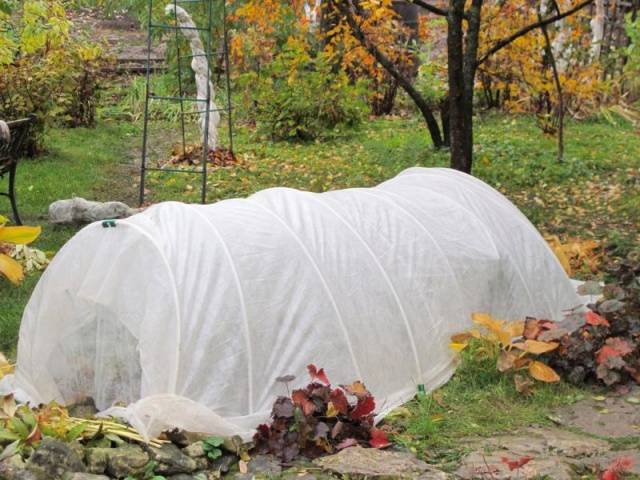

The most resistant varieties of roses for winter cold
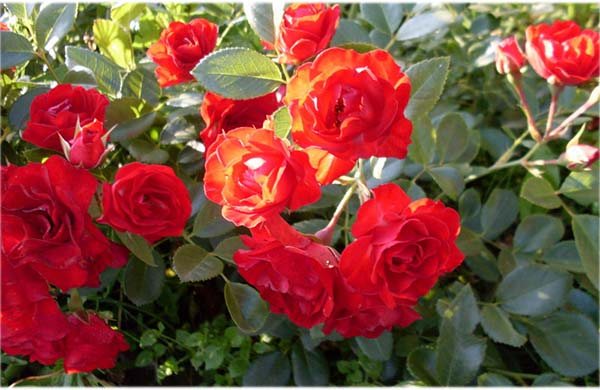

Ground cover roses are unpretentious to care for and look great in any corner of the garden. Some of the most reliable and winter-hardy varieties of this species: Scarlet; The Fairy; Swany. They grow horizontally, creating a luxurious carpet of colorful bizarre bushes, and have a wonderful scent.


Shrub roses can be grown in small groups, and subsequently create beautiful bouquets from them. Among the varieties grown for unique flower compositions, Black Magik is unpretentious in care; Rugelda; Golden Celebration; New Dawn.
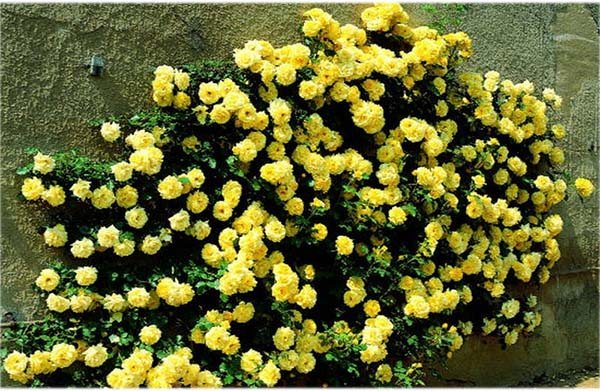

Many gardeners prefer climbing plants - they thrive in all weather conditions, do not take much time to care and pleases with abundant flowering throughout the summer. Climbing roses are distinguished by longer flexible shoots, with their help you can create a flowering arch, decorate the facade of a house, make a stunning arbor, fragrant with inflorescences. Cold-resistant and unpretentious varieties of climbing roses: Simpathie; Golden Showers; Heidelberg.
If you put in a little effort in the fall to grow one of the most wonderful and mesmerizing plants, your garden will smell with roses in the spring and take on a truly luxurious look. Breathing life into the queen of flowers is not so difficult, the most important thing is the care and patience of the gardener, following simple recommendations, and, of course, the desire to find a beautiful, delightful site.
Landing conditions
We will find out in what conditions a rose should be planted, what place is suitable for this plant.
Seat selection
Plant your roses in an area that is well lit and warmed by the sun's rays. These flowers do not like shadows, they lose their decorative effect when grown in such places. It is important that the site is protected from wind gusts that harm the delicate rose.
Low-lying places are not suitable, it is better to choose a small hill. Make sure before planting that the groundwater in the soil is no closer than a meter to the surface. If the area is waterlogged, drainage will be needed.
Soil composition, pit preparation


In order for the rose to successfully take root and develop, to bloom, it should be grown in loose and fertile soil, with a high content of organic matter, well moisturized. It is better to prepare the soil some time before planting.
Mix organic fertilizers: compost, humus and manure, taking the components in approximately equal proportions. Add some bone meal and wood ash. All fertilizers should be mixed with the top of the soil that has been removed from the pit.
The hole is dug 65 cm deep, its width and length can be from 40 to 65 cm, focus on the volume of the rose roots. If the area is too loose, and the soil contains a lot of sand, it will not hurt to lay a clay pad 5 cm thick on the bottom of the hole. Clay will help protect the roots from drying out too quickly, water evaporation. In the event that the substrate, on the contrary, contains a lot of clay, dilute it with gravel sand.
Planting roses in the suburbs: terms, rules and care
Roses are preferably planted in spring, and May is the best time for this. In order for the planting to be successful, the rose seedlings and the planting hole must be prepared in advance, providing the capricious queen of the garden with the best nutrition. The main thing after planting is to help the plant grow roots, so that it can stock up on vitamins and endure the winter.


Planting dates for roses
The sooner the acquired seedlings are planted, the faster the plants will take over, because long overexposure does not benefit the seedlings.
- If the planting place for roses was prepared in the fall, you can start planting as soon as the soil thaws on the bayonet of the shovel.
- If the place for planting roses was not developed in advance, we are waiting for the soil to thaw for one and a half bayonets of a shovel
- In the conditions of the Moscow region, early planting of roses is preferable, it is advisable to have time with it before mid or late May.
- At a later spring planting, roses are less accepted.
- It is advisable to refuse the autumn planting of seedlings.
Preparing roses for planting
1. If rose seedlings are stored in the refrigerator before planting, then a few days before planting they need to be taken out so that there is no sharp temperature drop.
2. The day before planting, the seedlings are soaked in any stimulant solution, and they must be completely immersed in it.
3. I preliminarily clean the seedlings of peat and unfold the roots, usually they are bent, at the point of inflection I cut off the roots with a pruner.
4. A tank or a wide container is suitable for soaking seedlings. If the seedlings still do not fit into the container, I put a large bag on top and tie it around the bucket in which the seedlings are located, so due to the evaporation of the liquid, the plants are evenly saturated with the solution.
5. If you need to plant roses with a closed root system, that is, in a pot, then soak them together with the pot, immersing the container completely in the nutrient solution. To prevent the pot from rising, I put several small stones on it. ____________________________________________________________________
Preparing the soil for planting roses
- If the groundwater is close, then in the conditions of the Moscow region, I put drainage at the bottom of the planting pit - expanded clay or sand.
- The approximate size of the landing pit is 30X30 cm and a depth of about 40 cm.
- Fresh manure can be put on top of the drainage, by the time the roots reach it, it will already be rotted.
How to make potting soil for planting roses
Roses, wayward beauties, love nutritious soil. Therefore, I am preparing a special mixture for them.
- I take two buckets of compost, a bucket of clay, the rest of the volume is the soil taken out of the pit.
- I add two glasses of bone meal and the same amount of ash, half a glass of complex mineral fertilizer and the same amount of superphosphate.
- If available, it is good to add a spoonful of a long-acting mineral complex fertilizer, for example, "Ava".
- I mix everything thoroughly and put it in the pit.
I mix all the components of the potting soil mixture for roses right in the wheelbarrow. _________________________________________________________________
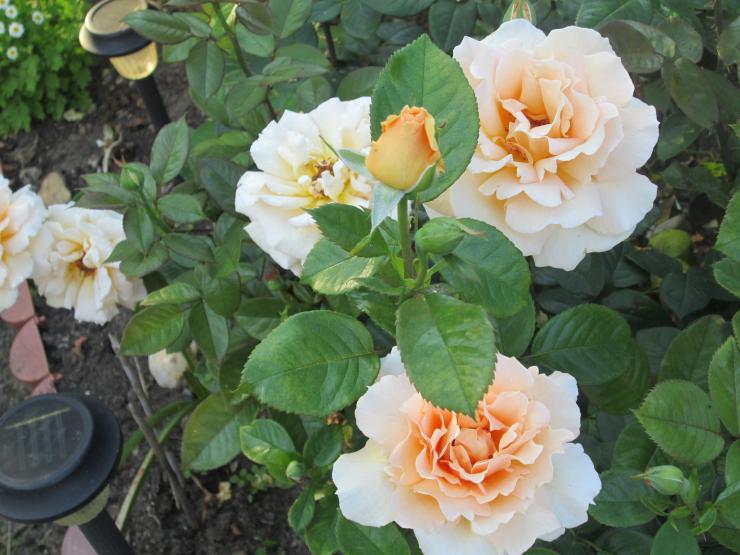

Rose planting rules
- To prevent the roots from touching the fertilizers mixed in the ground, you need to make a "capsule" of sand.
- After removing the seedling from the nutrient solution, you need to examine the roots. Trim and sprinkle all broken and rotten ones.
- Often, by the time of planting, seedlings give rather long shoots. Long are considered to be more than 4 cm. I always twist them carefully or cut them off at the base of the trunk. A strong seedling after planting will give new shoots, they will be strong and strong. If you leave long, elongated shoots, the rose will look like a loach.
So the plants will be protected from frost and, possibly, will eventually move to their own roots, which will also increase its frost resistance.
Caring for roses after planting
Watering after planting
- After planting, I water the roses every other day if the weather is hot.
- After watering, I cover the formed hole with earth.
- For watering, for the first time I use the same solution in which the seedlings were soaked.
Shelter after landing
I shade the roses right after planting.
- If the rose garden is large, I set arcs and cover with the thinnest non-woven fabric. In the case when several rose bushes are planted, a structure made of strong sticks will do.
- On the north side, the end of the shelter can be left ajar, but you need to fix the material properly so that the wind does not open the landing.
- I do not remove the covering material for about 2 weeks, I open the plantings only in cloudy, preferably rainy weather.
Flowering after planting
- In the first year of planting, I do not give roses to bloom.
- As soon as the shoots reach 15 cm, I pinch their tops.
- It is important for roses this year to build up a powerful root system.
- Only at the end of August I allow the shoots to throw out the buds and do not cut off the faded roses until the moment of shelter, so that all the shoots are lignified.
If you allow rose seedlings to bloom in the year of planting, then the plant will spend all its strength on flowering, the roots will not grow, and in winter it can freeze.
Choosing a site for growing roses
The seedling will take root well, and will actively grow only in the correctly selected area. In this case, it is necessary to take into account some requirements. The fact is that a rose is a rather whimsical plant for which you need to create suitable conditions.
Rose loves warmth and sunshine. Therefore, only well-lit places are chosen for growing the "queen of flowers". On the north side, the flower garden can be covered with buildings, the main thing is that the south side is completely open. Bushes should not be blown by winds from all directions. In addition, the rose does not grow well in shady places. For this reason, the plant is not planted near trees and lush shrubs.
Attention! Rose bushes will not thrive in wet clay soil.
The groundwater level in the area with roses should not be too high. Stagnant moisture can provoke rotting of the root system. In such conditions, the roses will simply die. What kind of soil is suitable for growing roses?
There are 3 main criteria:
- loose fertile soil;
- the level of soil acidity is slightly acidic;
- a sufficient amount of mineral and organic fertilizers.
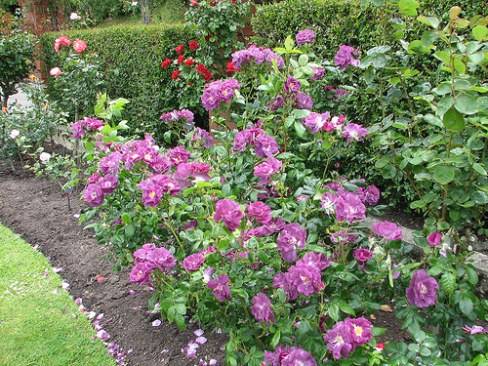

To plant seedlings, you need to prepare the site in advance. To do this, they carefully dig it up. At this stage, you can apply mineral fertilizers. The amount of nutrients is determined according to the instructions. A month before planting a bush, you need to fertilize the soil with compost or humus.
Planting roses in the fall: rules and recommendations
Experienced gardeners advise to carry out autumn planting of roses for better survival and hardening of plants. At the same time, the flowering period begins faster, and the bush itself will delight with good immunity and resistance. Why the autumn planting of roses is preferable, the main secrets of choosing a seedling, as well as how to plant roses in the fall, our article will tell.
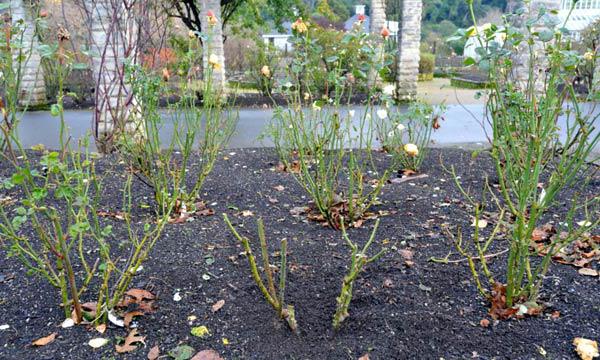

Landing dates
There are no definite and exact dates for the autumn planting of roses: they are different in each region. The most important thing is to plant flowers in such a way that they have time to take root in the ground before frost. Usually, gardeners take into account the climate in the region and take into account the fact that it takes about a month for the final rooting of roses.
Optimal period: from mid-September to mid-October. The closer the region is to the north, the earlier you should plant. Keep in mind that successful rooting will take place if the temperature is about + 10-15 degrees during the day and will not drop below +5 degrees at night.
Planting too early is undesirable. If you plant roses, say, in August, then in favorable warm weather they will be able to have time to release leaves, which, of course, will be beaten by frost. Such a plant will be much worse overwintering. But you can't drag it out either: it's too late to plant in November.
Benefits of autumn planting
Any garden plant is planted in open ground, planted or propagated only during a period of low vegetation activity. This happens either at the beginning of spring or at the end of the summer season, when life processes gradually subside. Planting roses in the fall is more successful, because additional time is required for the normal adaptation of the bushes.
To do this, the timing of planting roses in the fall is determined depending on the climatic region of cultivation, usually from September 15 to October 15.At least a month remains before real frosts, during which the root system will have time to properly strengthen in a new place, and the aboveground part will not sprout new buds. If you hurry too much, rose bushes with blooming buds will inevitably freeze out, or they will hurt in the future. In the Moscow region, planting of roses is usually carried out in October, and for more southern regions, the dates can be shifted by two to three weeks.
Planting roses in the fall also has several advantages:
- The plant adapts better.
- Flowering begins a year faster.
- The bushes are well hardened.
- Leaving after planting is less problematic.
- In the fall, rose seedlings are much cheaper.
- After winter, the plants are weaker, which inevitably affects the successful survival rate.
- You can plant cuttings of roses yourself planted in spring.
It is advisable to purchase rose seedlings for autumn planting in proven nurseries. When ordering online, it is better to purchase sprouts with a closed root system - this way they have a better chance of successfully transferring transportation. It is best to use zoned varieties for growing, but with proper care and proper planting, even thermophilic roses take root well in the conditions of the Moscow region and Central Russia.
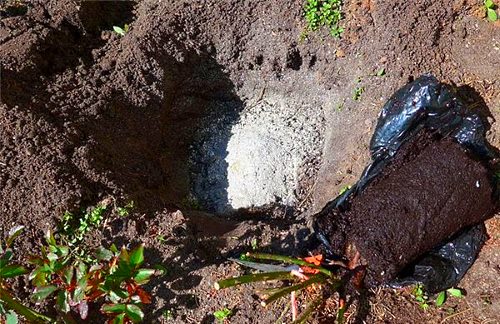

Optimal terms for different regions
Roses are planted when at least a month remains before the first frost at a daytime air temperature of 10-15 ° C and a minimum of 5 ° C at night. Recommended timing for different regions:
- southern Russia and Ukraine - the last decade of October and the first half of November;
- the middle zone of Russia and Belarus - the end of September and the first two decades of October;
- Northwest region - second half of September and early October;
- Urals, Siberia - the first decade of September (or generally the end of August).
The lunar calendar prohibits any planting work on the days of the full moon and new moon. The most favorable period for this is the growing moon in the signs of Taurus, Cancer, Libra, Scorpio, Pisces. Less successful, but also acceptable is her stay in the signs of Virgo, Capricorn.
Selection of seedlings
Planting roses in the open in the fall is preferable to seedlings with an open root system. So you can make sure of the viability of the plant, as well as stimulate root growth with special solutions. To do this, the purchased seedling must be soaked in warm water for a day, to which add a stimulating solution or dissolve a little sugar. After that, the roots of the plant are slightly trimmed, and the process itself is transplanted to a permanent place. Many factors affect the success of planting, therefore, when choosing a seedling, you should pay attention to its condition.
Signs of a viable rose seedling:
- Three main shoots are well developed. They have approximately equal length, uniform color and surface.
- There should be no traces of damage, rotting areas, or dry processes on the roots.
- A healthy seedling must have several young shoots and leaves.
When buying seedlings of roses with a closed root system, you should pay attention to the earthen lump in the package. If the soil is too tight against the sides of the container, this is a very negative sign. In general, if possible, it is better to purchase seedlings with bare roots. If the rose is waiting for transportation, or it is impossible to immediately plant the purchased seedling in the ground, the roots must be closed.
Before planting rose seedlings in the fall with an open root system, it is advisable to dip the roots of the plant in a previously prepared "chatterbox" of cow dung and clay (proportions 1: 2). This will protect against pests, and spraying the bush after planting with a 3% solution of ferrous sulfate will provide reliable prevention of fungal diseases.
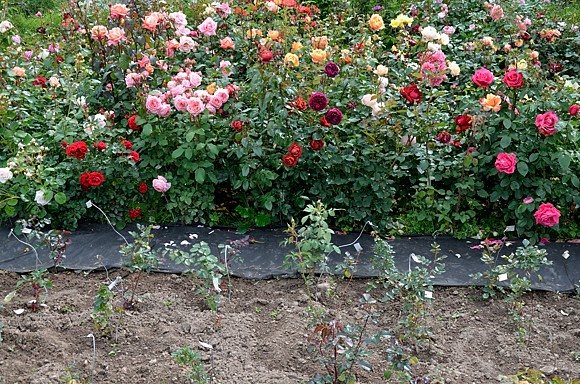

Further care of seedlings
One of the undoubted advantages of the autumn planting of roses is that the plant needs minimal care before the cold weather.The macro- and microelements necessary for preparation for winter have already been introduced into the planting pit, pruning was carried out during planting, the prevention of fungal diseases - in preparation for it. Weeds grow much less actively in autumn than in spring, pests hibernate. Watering, as a rule, is also not required, unless the fall is very dry and warm. In this case, the substrate will have to be moistened every 3-5 days (5-7 liters of water each).
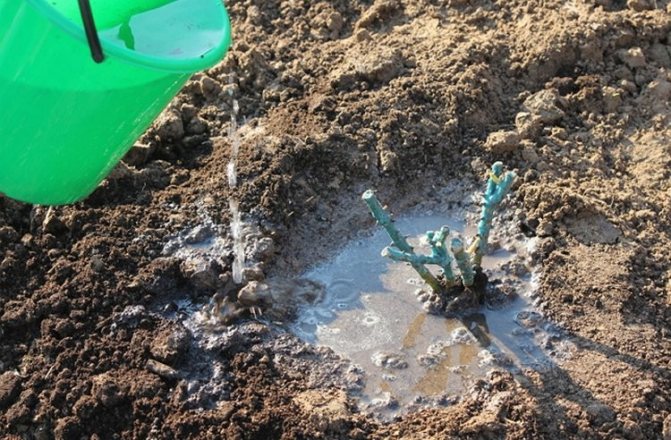

Watering after planting in the fall is needed for a rose only when there is no natural precipitation
When planting in autumn, special attention should be paid to preparing the rose for winter. Even if the frost resistance of the variety seems to allow it to survive the cold in your region without losses, it is better to insure yourself and insulate at least the roots.
The trunk circle is cleaned of plant debris. Humus is poured into the base of the rose bush with a mound about 25 cm high. Shoots, if possible, are tied, the rose is covered with spruce branches or wrapped with white covering material in 2-3 layers. You can also cover the seedlings with special covers, cardboard boxes or wooden boxes of a suitable size, build a "hut" (a frame made of poles or greenhouse arches, covered with the same covering material). Shavings, scraps of newsprint, sawdust are poured inside.
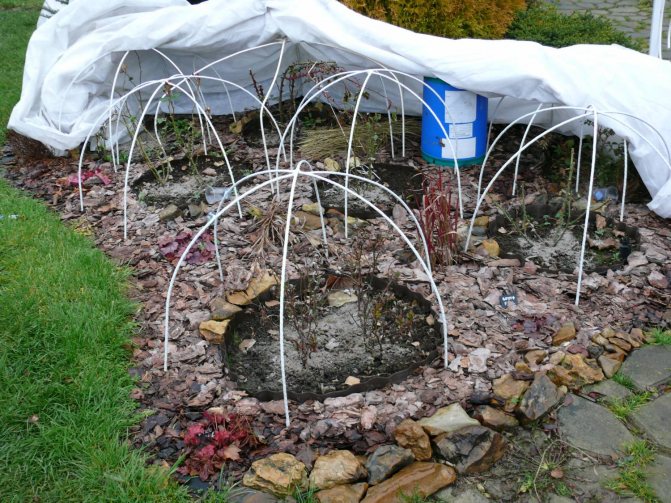

The earth gives warmth to wintering roses: accordingly, the larger the area is closed, the less the risk of freezing
Video: sheltering roses for the winter
Soil preparation and planting
Before planting rose seedlings, you need to properly prepare the soil. It is advisable to do this two weeks before planting the plants, so that the soil has time to settle and be saturated with moisture. Roses are very fond of sunny places, closed from drafts. For comfortable growth, there should be no darkening here, but the sun can negatively affect flowering. It is imperative to pay attention to good drainage, because from stagnant groundwater, the roses will hurt and wither.
The preparation of the landing site also takes into account the qualitative composition of the soil. For too dense clay soils, you should definitely dilute the composition with organic fertilizers, or prepare a special soil mixture. To do this, it is necessary to mix loam with humus in equal proportions. A drainage layer (broken brick, expanded clay, crushed stone) must be installed at the bottom of the planting pit, and a layer of clay can be used to stabilize sandy soils.
How is the landing:
- The planting hole should be at least 40 centimeters deep and half a meter in diameter.
- Drainage and a layer of fertile soil mixed with wood ash are poured to the bottom to disinfect the soil.
- The seedling is set at the bottom of the pit, the roots must be well spread. The root collar deepens to a distance of at least 5 centimeters. All shoots below the grafting should definitely be cut off, because these are the "wild" parts of the bush.
- The pit is covered with fertile soil, all air voids are carefully compacted. This is necessary so that the earth does not push out the planted plant in the future.
- Aerial shoots are slightly shortened. It is imperative to remove leaves and buds, as well as thin twigs, which still do not overwinter, but can become a source of decay and spread of the fungus to other parts of the plant.
- The landing site is abundantly spilled with water. This procedure also helps to remove all voids from the ground.
- After the moisture is absorbed, the root area is covered with dry peat and mulched.
- Before the onset of freezing temperatures, the bush is watered every other day.
- With the threat of the first frost, the bush is covered with sawdust, peat and covered with agrofibre. You can use branches and spruce branches for these purposes.
The comfortable distance between bushes in a group planting depends on the variety and size of the roses. Floribunda and hybrid tea varieties are planted at a distance of at least 30 - 60 centimeters from each other. For parks, it is necessary to leave 70 - 90 centimeters, and for weaving and standard ones - at least a meter.
If for some reason the time for planting is missed, you can leave the seedling with a closed root system in a room where the lower temperature does not drop below 5 degrees Celsius. Roses with an open root system can be buried in a greenhouse, or in the ground in an inclined position and good shelter. With the onset of spring, the seedling moves to a permanent place of growth.
On the proposed video, a video of a phased planting is presented, as well as important nuances of planting roses in the garden are considered.
Typical mistakes of a novice rose grower
Planting errors can lead not only to slow development and poor flowering of the bush, but also to the death of the rose:
- choosing a place for a flower bed without taking into account the requirements of the rose;
- planting in a "heavy" substrate that does not allow water and air to pass through;
- excessive deepening of the root collar (it rots, the rose dies);
- roots not straightened in the planting pit (the plant does not take root well, develops slowly);
- neglect of mulching after planting (mulch prevents the growth of weeds and the rapid evaporation of moisture from the soil).
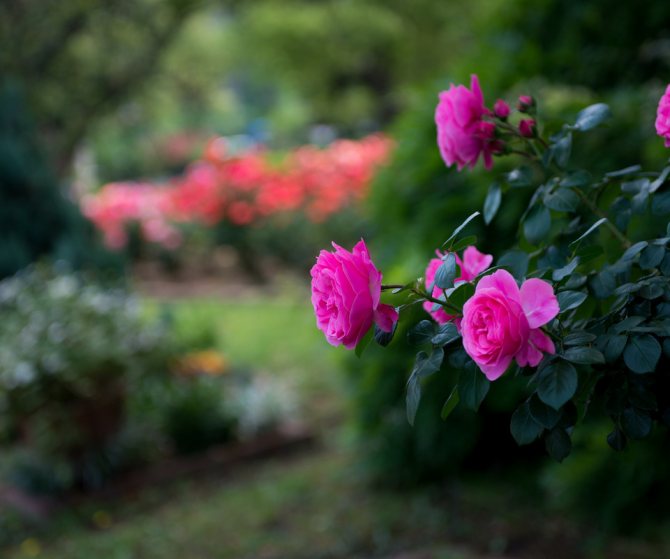

Good illumination is one of the main requirements of a rose to the place of growth, it must be taken into account
Conditions for further cultivation
You won't have to take care of the planted roses in the fall. It is advisable to water the seedling before the onset of frost, and also make sure that the plant does not start up new shoots and buds. This reduces the chances of a successful wintering, so such growth is ruthlessly removed. When the air temperature becomes quite cool, and at night there is a threat of the first frost, you should definitely take care of a winter shelter.
Usually, zoned varieties of roses winter well even without a special shelter, but in the case of a snowless winter, or frequent thaws interspersed with frosts, the roots of plants can be seriously damaged. That is why, experienced gardeners must cover all varieties of roses, regardless of their frost resistance.
Seedling selection and preparation
We strongly recommend buying rose seedlings (especially rare, varietal) in specialized nurseries, rose gardens. You can, of course, order on the Internet, but in this case it is very important to visually assess the condition of the plant when buying.
Examine the seedling: it should be small but well developed, with no signs of deformation or any damage. The plant should have at least three shoots with a flat surface and no signs of rot.
It is very important to correctly assess the condition of the roots. This is the main part of any plant, and it should not have any black areas, spots, dried individual roots. The seedling should have healthy, well-developed, light-colored and firm roots.
Preparation
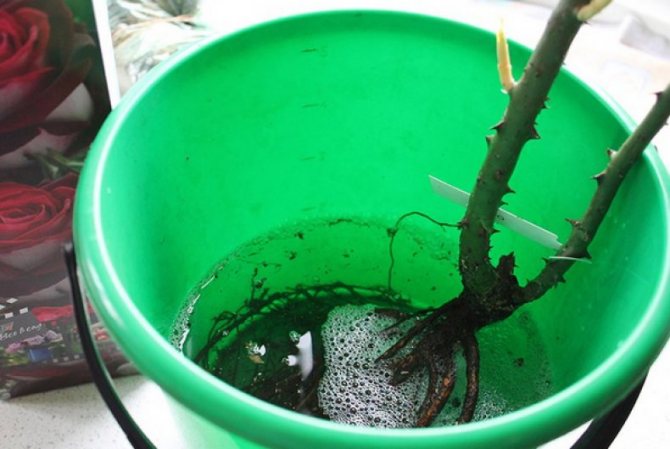

Inspect the seedling, paying special attention to the condition of the roots. Cut too long roots: the resulting length should be about 25-30 cm. Decontaminate the root system in a fungicidal solution (potassium permanganate can be used).
If the roots are a little dry, and this happens when transporting a seedling, place the lower part of the plant in a special life-giving solution. This liquid consists of water (10 l), urea, superphosphate and a growth stimulant. Place the roots in the mixture for 12 hours.
Benefits of autumn planting
Choosing between autumn and spring planting, many people prefer the spring months, since there are no frosts and cold snaps in the future. But the autumn landing has a sufficient number of advantages that force us to reconsider the views on the timing of planting:
- Air humidity at this time is much higher than in spring. This factor is very important for successful rooting and adaptation in a new place, therefore greenhouses are often used for cuttings, which increase the air humidity in the inner space. During September-November, this parameter fluctuates between 75-85%, while in April-May it rarely reaches 65%.
- The amount of precipitation is much higher than at other times of the year, and rainwater has a much better effect on the rose at the time of rooting than tap water, which has to be used for watering in the warm season.
- Over the summer, the soil warmed up to a sufficient depth and retains a sufficient temperature for a long time, including after the onset of cold weather. In spring, even at a high outside temperature, the soil can be cold, which badly affects the adaptation of the plant.
- In September, a lot of autumn planting material with flowers on the bushes appears on the shelves, so you can be sure that you are buying exactly the declared variety, that is, there is no risk of acquiring another variety or a wild bush under the guise of a cultural one.
- Spring planting stock goes on sale after winter digging, so its potential directly depends on how it was stored. Autumn specimens tolerate transplanting much easier, since they vegetated in the open field in the summer and stored the necessary substances that will help to cope with stress.
- Already next year, overwintered bushes will start growing earlier and please with full flowering, while spring ones will not show the full strength of flowering in the first year.
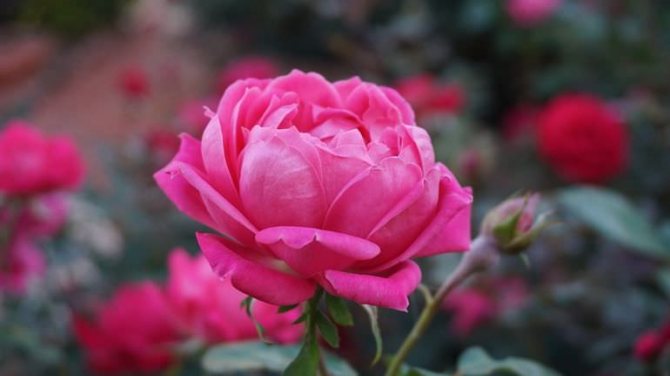

There are fears that the bush will not have time to take root in a new place until the real autumn frosts, but if everything is done in accordance with the rules, then normal wintering will be ensured.
If you are late with planting roses
It happens that the necessary seedlings of roses are brought late and the planting time has already passed. What to do in this case?
Do not strive to plant bushes faster. It is better to dig them in a slightly inclined state in a greenhouse or in a trench until spring.
With the onset of frost, cover the place with dug-in rose seedlings with spruce branches, peat, and in winter add snow.
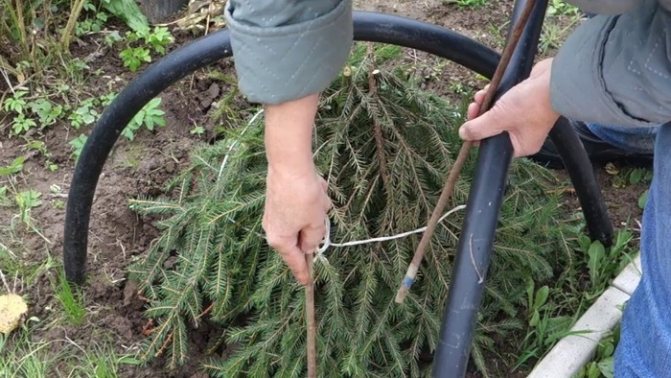

You can also store rose seedlings in the basement with a temperature of 0-1 degrees.
In the spring, these seedlings need to be removed from a basement or shelter and planted in open ground in a permanent place.
Video planting roses in autumn
The rose is the most beautiful creation of all flowers. It is not in vain that she is called the queen of the garden, because she is endowed with a bright and catchy beauty that leaves an indelible mark on the soul. But before starting it in their garden, gardeners are wondering whether it is possible to plant roses in the country in the fall, how to carry out the procedure correctly, what are the features and rules for autumn planting. All the answers to these questions are below!
When to plant roses in open ground - in spring or autumn
Rose seedlings can be successfully planted throughout the warm season, but traditionally spring or autumn is chosen, the maximum number of seedlings goes on sale.
Timing and benefits of spring planting
Most retail chains start selling seedlings at the end of February, from which time gardeners are preparing to replenish their collection. But even in the south, this is not a good time to disembark. Purchased plants are stored until warm days in a cool place, waiting for suitable conditions:
the soil is completely free of snow, thawed; the air temperature does not drop below + 10 ° С for several days in a row; the weather forecast does not foretell the return of frost.
Additional Information! Rose seedlings are planted when dandelions bloom.
The advantages of spring planting are that over the summer the seedlings will form a strong root system that can withstand frosty winters without problems, plus young shoots will have time to fully mature, the wood will not suffer from the cold.
Gardeners choosing spring bring another argument - easier care, no need to rack their brains over the advisability of watering.
Timing and benefits of autumn planting
The advantage of planting roses in autumn is more predictable weather, well-warmed soil, cool nights, which contribute to the rapid survival of seedlings. The next year, the bushes will bloom fully.


Preparing for landing
The generally accepted rule is that the last bush is planted no later than three weeks before the onset of the final cold weather. Another important point is that the night temperature should not be lower than + 10 °, the maximum daytime temperature should not be + 15 ° C. The flowering time of the planted varieties is also taken into account - the earlier the buds open, the earlier you need to plant a rose. The timing is considered optimal from the second decade of September to mid-October, in the southern regions, the dates are shifted, planting there can be carried out until the first day of November.
Note! Floribunda roses are best planted in spring. Late planting - mid-May is suitable for hybrid tea varieties.
Preparation of seedlings
It is better to purchase seedlings in nurseries. In this case, the risk of purchasing a low-quality product is excluded. In spontaneous markets, they can offer seedlings of elite varieties of roses, which in fact are not.


Also, the choice of seedlings should depend not only on the preferences of the grower, but also on the climatic features of the area. Experienced flower growers recommend giving preference to zoned varieties of roses. In this case, the probability of plant death due to unfavorable weather conditions is unlikely.
One day before the proposed planting of rose bushes, work needs to be done to help prepare the plant for a new habitat. If roses were purchased in containers, it will be quite enough to water them abundantly 12 hours before planting.


If seedlings with open roots were purchased, then the preparation will consist in performing the following actions:
- The plant is carefully examined to exclude the planting of an infected seedling.
- Leaves, dry roots are removed.
- Healthy roots are shortened, leaving about 30-40 cm of their length.
- Shoots are also subjected to shortening to 2-3 buds.
- Carefully inspect the vaccination site. Buds should not develop near it; if found, they must be removed in order to exclude further growth of shoots.
- Prepared cuttings are soaked for one day in water, in a special solution of rooting stimulants, fungicides.
- Before direct planting, the seedlings are kept in a clay mash.
Tips from experienced florists
People who have been dealing with roses for a long time and have accumulated sufficient experience recommend following the following rules in the process of planting roses:
- Do not plant roses in peat soils as these types of soils hold too much moisture. This can cause root rot.
- Plant flowers in loamy soil. In such a soil, there is good aeration, there are enough useful elements and a good water regime is maintained.
- When planting, bury the roots to the recommended depth and spread them out. This will serve for good rooting and overwintering.
- Do not water with cold water.
Planting roses in the open ground in autumn should take place according to certain rules and taking into account the characteristics of the plant. To achieve success, you should take into account the experience of venerable florists and follow our recommendations outlined in this article.
With care and patience, you end up with a delightful plot with mesmerizing flowers.
The necessary conditions
It is very important to provide the seedlings with the required conditions. Only in this version will plants grow and develop well, delighting their owner and his guests with magnificent flowering.
Let's see what conditions roses need for normal growth.
- One of the most important requirements is to provide plants with sufficient nutritional area when planting. That is, it is important to adhere to the recommended landing pattern.
- The choice of territory for planting roses. It is good if the place is sufficiently lit, but covered from the midday rays - they can burn the leaves.
- Experienced growers advise planting flowers in the western or southeastern outskirts of the garden. Then the morning rays will fully reach the flower garden, and in the middle of the day a shadow will fall on the roses.
- Planting is best done on a slope, in ridges raised by 30 cm. Then the roses will endure the most severe frosts, and in spring they will not get wet from melt water.
- When planting, it will not be superfluous to take into account the acidity and moisture of the soil. Slightly acidic soils with a pH level of 6-6.5 units are considered optimal. And high soil moisture will definitely negatively affect roses.
- Autumn planting should be done in warm and dry weather. Air humidity should be 75-85%.
- Use seedlings with excellent roots and 3-5 shoots. When buying a seedling, scrape the root with your fingernail. A healthy root will be firm and white.
Attention! Planting roses in the open ground in autumn must be completed a month before the arrival of the first frost. This time is enough for a young seedling to take root and prepare it for winter.
Place for planting roses on the site
When choosing where to plant roses on the site, look for a sunny, well-lit place, protected from the winds. It is better if the groundwater is not too high. Rose does not like root soaking. Do not plant roses under the eaves at home. There, the water flowing down from the roof will stagnate.
An excellent place for a rose garden is the southern warm slope of the site.
And of course, let us remind summer residents that it is better to plant roses where they are clearly visible to the owners of the estate.


Do not plant thorny bushes of park large roses in the playground and close to garden paths.
It is worth considering that roses prefer fertile, rather loose soil. If your soil is not fertile on the site for the rose garden, it is worth applying fertilizers and organic matter a month before planting the bushes.
Diseases and pests
| Mottling Symptoms:
Prevention:
Treatment:
|
| Powdery mildew Symptoms:
Treatment:
|
| Greenhouse aphid or green Symptoms:
Treatment:
|
Reproduction methods
There are five ways to reproduce flowers. In order to properly plant roses in the fall using one of these methods, it is imperative to take into account the characteristics of the variety and the weather conditions of the area. You can propagate roses in the following ways:
- Cutting is the simplest and most reliable method of propagation, which involves the use of semi-lignified green cuttings. Planting the plant is carried out in a bed with a loose and fertilized substrate. Watering abundantly is recommended to reduce the risk of losing the cuttings. In most cases, the soil is covered with glass or plastic wrap to create a greenhouse effect. Due to this, the most comfortable conditions for the growth of the rose are provided.
- If there is a shortage of planting material, the method of dividing the bush is used. In the spring, during flowering, the bush is divided and re-planted.
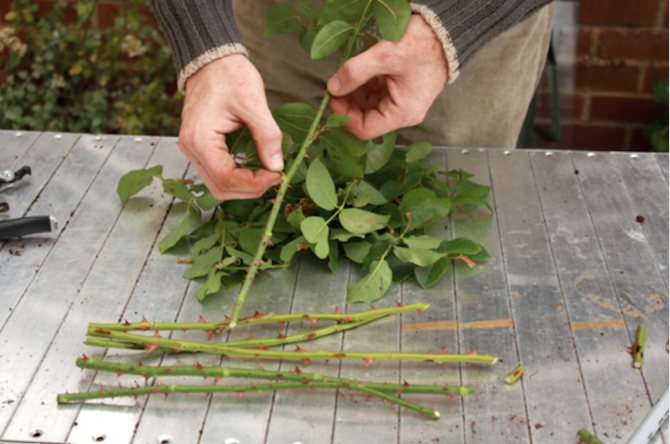

With long and flexible stems of the plant, you can plant roses in shortened layers. In this case, the care should be more thorough, since the shoots may not take root. It is recommended to apply this method in early spring, since the roots already appear by the fall.- Reproduction by offspring is possible when a large number of basal shoots appear in the form of erect shoots.The offspring already have their own roots, so you can separate them from the mother plant. The division is carried out in the spring.
- Reproduction by grafting is used in the cultivation of varietal roses. For this, it is recommended to choose a stalk without obvious problems. After planting, regardless of planting time, cover the plant with a plastic bag.
You can plant roses with roots in autumn without fear of their withering away due to low temperatures. To do this, it is enough to place the plant in a deeper hole.
How to plant roses - step by step instructions
The rules for planting roses in autumn and spring are the same. They must be observed strictly, most of the bushes grow in one place for more than 20 years.
The optimal distance between bushes
Rose bushes love free placement. But the correct landing pattern is rarely adhered to in practice. The yard of a private plot is not a plantation, this culture is not garden, but decorative. The distance between roses when planting in the ground is often determined by the requirements of landscape design, the size of the site, the availability of free space, and not agricultural technology. These are the realities.
Most varieties of roses allow this, although they require careful maintenance later. The exception is the aforementioned capricious Ostinki. They will tolerate a compacted planting, but in response can ruin the appearance of the flower bed.
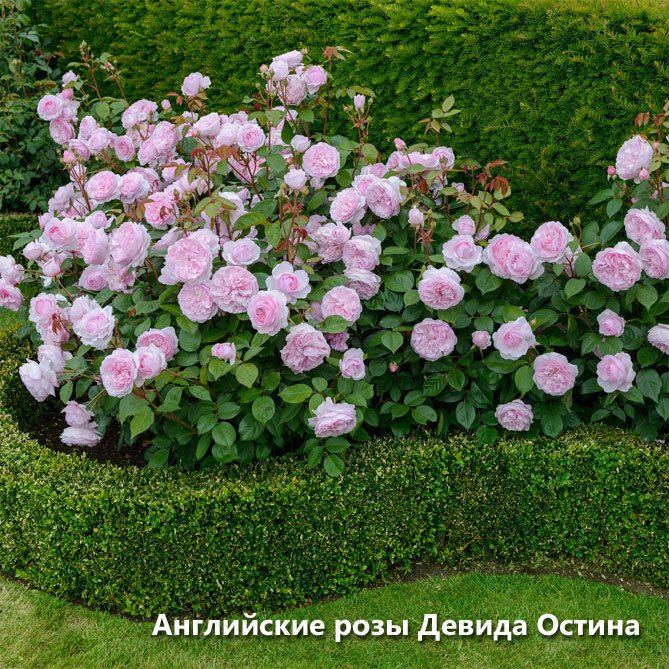

The table shows the average interval at which you need to place rose bushes when planting.
| Type of roses | Distance between plants, m |
| Miniature | 0,3 |
| Patio | 0,5 |
| Low-growing hybrid tea, floribunda | 0,5 |
| Medium hybrid tea, floribunda | 0,6 |
| Tall hybrid tea, floribunda | 0,75-1 |
| Conventional standard | 1,2 |
| Weeping standard | 1,8 |
| Climbing | 2-3 |
| Shrubs | half of the estimated height of the bush, but not less than 1 m |
| Groundcover | diameter of the estimated distribution of the bush (see the varietal description) |
You can grow a hedge from roses. It is convenient to use rooted shoots propagated by cuttings. It is much cheaper as the hedge requires a lot of shrubs to be planted at the same time. If you're lucky with the variety, you can even root the branches from the bouquet.
The correct planting of rose cuttings for a hedge depends on the height of an adult bush:
- tall (from 150 cm) are placed in one line at a distance of 60 cm;
- a medium-sized hedge (75-100 cm) is planted with two lines in a checkerboard pattern, 45 cm is left between the rows and bushes.
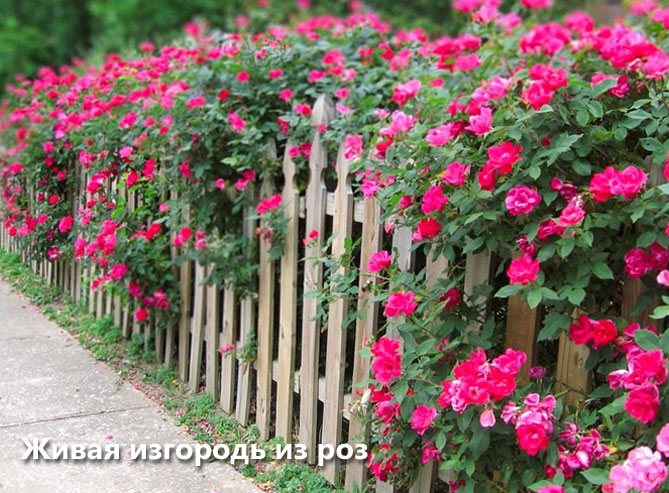

Preparation of planting holes
In the planting hole, the root should fit freely, straighten out. Standard size - diameter 60 cm at a depth of 40 cm may vary:
- on poor, dense soils, the volume of the pit is made large;
- constantly blocking areas require an increase in the depth of the pit by at least 20 cm - drainage must fit there;
- for rooted cuttings, consisting of a thin twig and an underdeveloped root, the deepening is made 2 times smaller.
A fertile mixture for planting is prepared from equal shares:
- turf land,
- humus,
- peat.
What else is worth adding to the soil:
- in areas with dense loams, sand is added;
- clay is used for sandy loam;
- deacidify the soil with lime, dolomite flour;
- leached with high-moor peat;
- fresh fertile chernozems before planting improve slightly, with a small amount of humus.
What fertilizers to apply is decided based on the composition of the soil.
They bring under the roses:
- superphosphate,
- potassium sulfate or ash.
It is better not to be zealous with nitrogen, its source will be humus introduced during planting, mulching the trunk circle. Nitrate dressings dissolve easily with water and can be added directly under the bush. If nitrogen is included in the fertilizer used during planting, you must follow the instructions.
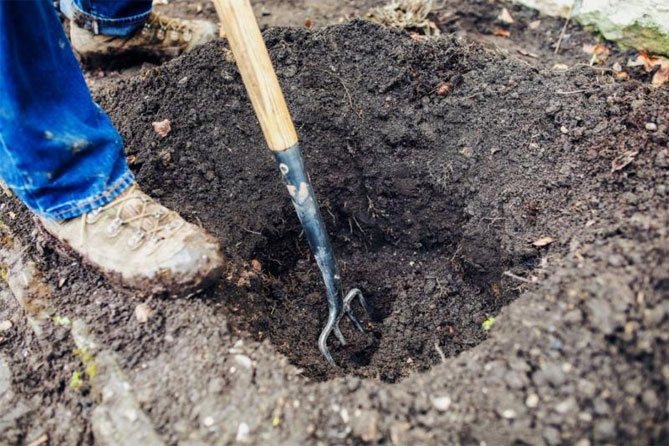

The pit is filled 2/3 with the prepared substrate, filled with water. After 2 weeks, you can start planting.
Direct landing
Before planting, bushes with an open root are soaked for 6 hours, adding a root formation stimulator. The pit is filled with water.When the liquid is completely absorbed, you can start planting:
- A part of the substrate is taken out of the pit.
- A mound is formed in the center.
- At the top, a rose bush is installed so that the root collar is flush with the edge of the hole or slightly lower.


- Spread the roots.
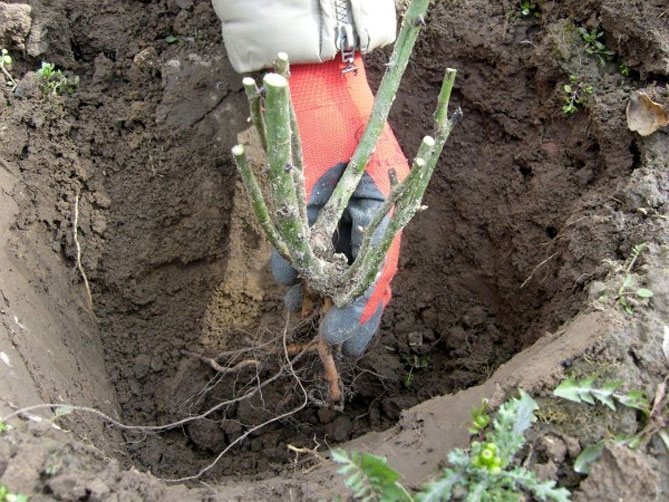

- Gently sprinkle with a fertile mixture, squeezing so that voids do not form.
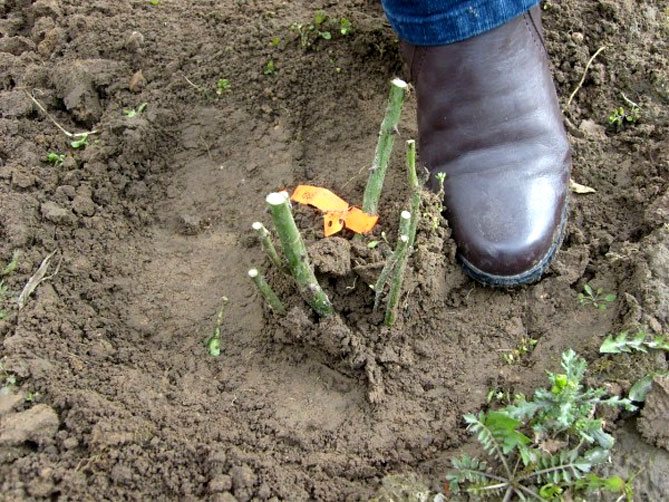

- Water the rose, spending at least a bucket of water per bush. The root collar will drop slightly - it should be located 3-5 cm below ground level.
- Sprinkle the soil.
- Around the perimeter of the planting pit, an earthen roller 8 cm high is formed.
- The trunk circle is mulched with dry humus.
For container plants, a pit is prepared such that an earthen lump is surrounded on all sides by a layer of prepared fertile mixture of 7-10 cm. The pot is cut if the bush is difficult to reach. This will preserve the integrity of the coma, not injure the root.


Features of planting different types of roses
If the rose bushes are planted in the fall, pruning is not needed. In the spring, shoots are shortened to 10-15 cm in all varieties, except for climbing ones.
Each variety of roses has specific planting requirements:
- For ground cover varieties, the soil is prepared carefully, the hole is dug 2 times less than the standard one. The roots of weeds are removed completely - it will be difficult to deal with weeds.
- When planting climbing roses, they take care of the support in advance. If the bush is placed next to a fence, a capital wall, a hole is dug at a distance of at least 50 cm.The root is not placed symmetrically, but directed in the direction opposite to the wall.
- Standard roses are planted first in the flowerbed. First, a peg is dug in, deepened by 60 cm. The wooden one is pretreated from decay. The trunk is placed 4-5 cm from the support. The planting of standard roses is carried out at the same depth as the seedling grew before. If necessary, cut off the upper tier of the roots.
- English roses are very beautiful and just as moody. The design of the site is adjusted to them, and not vice versa. The bushes are placed freely so that nothing interferes, according to all the rules of agricultural technology.
The most frost-resistant varieties
Let's get acquainted with the most resistant to cold and frost varieties of roses, which are suitable for growing in the middle lane and even in Siberia.
Leonardo da Vinci


A very beautiful rose with rich crimson double buds. In addition to many lush flowers, the plant also has abundant foliage, a dark green hue. The bush itself is erect, branched, but low, takes up little space on the site. In addition to winter hardiness, the variety can also boast of abundant and long flowering, resistance to waterlogging. The buds are not afraid of rain, do not fade from the sun.
Golden Celebration


The famous variety of English roses with gorgeous golden yellow buds. In addition to a rich, slightly copper shade, the flowers are also surprisingly large in size. Drooping shoots, very decorative.
Faery
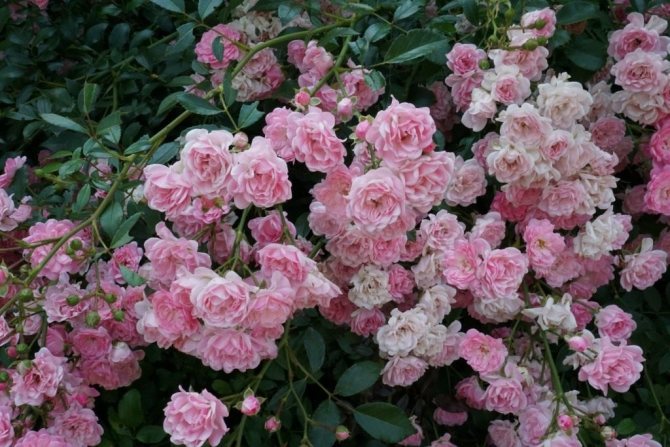

An old variety, bred back in 1932. But until now, the Fairy rose has not lost its popularity. Belongs to the polyanthus group. Differs in unique unpretentiousness, survival rate, stability. It blooms almost continuously throughout the season. If grown in the southern region, it can bloom all year round.
It is easy to grow - ideal for beginners. The buds are medium-sized, but multiple, of a beautiful pale pink shade. Easy to cut, forms into a neat bush.
Westerland


Also a famous variety, bred in 1969. Refers to scrubs (bush roses). Along with unpretentiousness and stability, it has pronounced decorative properties.
The buds are semi-double, regular bowl-shaped, large, painted in a unique fiery shade, gradually reaching a pinkish-salmon tone as it blooms. In the middle, the flowers are always golden yellow, their edges are wavy.The plant blooms without interruption throughout the summer season, it tolerates winter well. A very aromatic variety.
We got acquainted with the peculiarities of the autumn rainfall of roses. As you can see, there is nothing too complicated: having learned some of the subtleties, you can easily plant roses correctly, without annoying mistakes.
Planting autumn roses in open ground is not an easy task, especially for novice florists. We will tell you in this material how to plant a rose bush correctly and give the most complete and best instructions for planting a rose.


Florist reviews
Svetlana0604
I planted it in spring and autumn, depending on when the mood appeared to acquire a new beauty. Everything is accepted well if you follow all the landing rules.
Alexrus
It is necessary to carefully lift the rose with a pitchfork in the spring, while the earth is saturated with water. Then this procedure does not harm her. To make it start better, cut it off in the spring to 2 or 3 lower buds and then simply have to fluff up
What kind of roses to choose for breeding
miniature and hybrid polyanthus varieties are suitable;
- semi-leafy species;
- climbing varieties of roses belonging to the rambler group;
- excelsa flowers;
- large-flowered view Flammentants;
- representatives of the Floribunda group belonging to the Iceberg and Rosalind varieties;
- specimens of hybrid tea roses take root quickly, but their root systems are less developed, so they should be bred by grafting.
For your information! Park varieties of roses and remontant roses are difficult to graft.
Follow-up care
Proper care of the bushes planted in autumn will help to save young seedlings in winter. Fortunately, no serious maintenance is required for the bushes (Figure 6).


Figure 6. A few weeks after planting, you can prepare the bushes for winter
Watering in autumn is usually not required, as it often rains at this time of the year, which can saturate the soil with moisture. The only exception will be roses planted in pots and outside of natural rainfall.
Until next spring, roses will not need feeding either. A layer of fertilizer applied during planting or pit preparation will be sufficient until next spring. If desired, you can spray the bushes with a weak solution of copper sulfate to protect against diseases and pests, but this event is optional.
You will find more information about planting roses in autumn in the video.
Planting methods
Rose planting can be done in several ways. The choice of the most suitable one is carried out taking into account the characteristics of the soil and weather conditions. The most common methods are as follows:
- Dry fit. The method involves pouring the soil mixture onto the bottom of the planting pit. It is recommended to place the seedling at a depth so that the grafting site is 3-5 cm below the surface of the ground. In this case, the use of special fertilizers is not provided.
- Wet fit. When using the method, sodium humate is dissolved in a bucket and mixed with water, after which it is poured into a pit. Then the seedling is lowered into the soil and covered with sand. This ensures an even fit of the roots with soil.
When planting, it is important to exclude the possibility of damage to the root system and the aerial part. It is not recommended to work in a bad hike, such as too high humidity or cold temperatures.
This is due to the fact that roses can quickly die under adverse environmental influences.
How are seedlings stored in the fall before planting
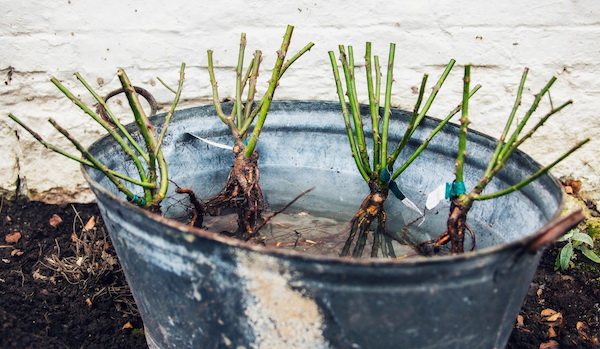

If you have acquired seedlings ahead of time and do not know what to do with them before the September planting, then we will tell you how to keep the seedlings for a while.
Cold storage
This is a very popular method as it is found in every home. Seedlings with an open root system are wrapped in a paper towel, pre-moistened with water, then placed in a synthetic bag and placed in the vegetable compartment, where the temperature is maintained from 0 to 3 ° C.
The same seedlings in containers must also be sent to the refrigerator. Before that, they are wrapped in a synthetic film.
Cellar storage
Rose seedlings keep quite well for up to 60 days in the cellar, with temperatures ranging from 0 to 3 ° C. To do this, they are placed in a bucket and sprinkled with moistened sand so as to cover the root collar.
Storing a flowering plant
If you purchased a container with a blooming rose, then you can put it at home, but not more than 3 weeks. During this period of time, the rose will have time to bloom, partially using the food from the container.
After disembarkation, it will quickly recover and develop.




